Regal V6-231 3.8L VIN L SFI (1990)

Chart C-8A Wiring Diagram
CIRCUIT DESCRIPTION:
The purpose of the torque converter clutch feature is to eliminate the power loss of the torque converter when the vehicle is in a cruise condition. This
allows the convenience of the automatic and the fuel economy of a manual transaxle. The heart of the system is a solenoid located inside the transaxle
which is controlled by the ECM.
When the solenoid coil is activated ("ON,") the torque converter clutch is applied which results in straight through mechanical coupling from the engine
to the wheels. When the transaxle (TCC) solenoid is deactivated, the torque converter clutch is released which allows the torque converter to operate in
the conventional manner (fluid coupling between engine and transaxle).
Each gear switch opens when the appropriate clutch is applied. All gear switches are open in fourth gear.
TCC will engage when:
^
Engine warmed up.
^
Vehicle speed above a calibrated value (about 40 mph 64 km/h).
^
Throttle position sensor output not changing, indicating a steady road speed.
^
Brake switch closed.
^
3rd or 4th gear switch open.
When operating in cruise control, the cruise active input to the ECM will allow TCC operation in 4th gear only.
TEST DESCRIPTION:Numbers below refer to circled numbers on the diagnostic chart.
1.
This test checks to see if the TCC solenoid is open.
2.
Checks fuse, brake switch and circuits 39 and 420 to the TCC solenoid.
DIAGNOSTIC AIDS:
The "Scan" tool only indicates when the ECM has turned "ON" the TCC driver and this does not confirm that the TCC has engaged. To determine if
TCC is functioning properly, road test the vehicle. Engine rpm should decrease when the "Scan" indicates the TCC driver has turned "ON."
